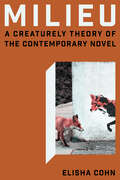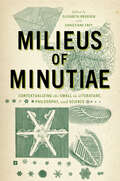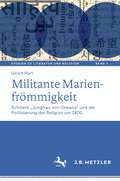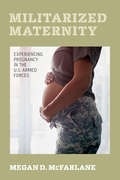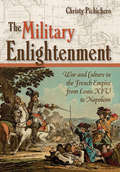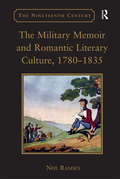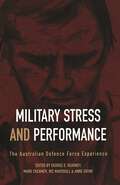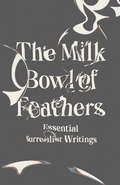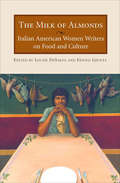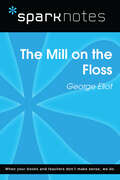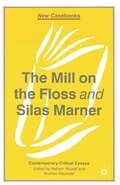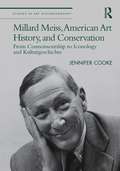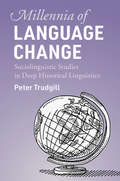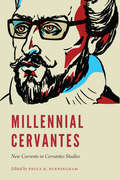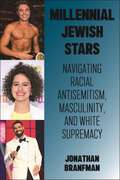- Table View
- List View
miLibro 5 [Grado 1] (¡Arriba la Lectura!)
by Kylene Beers Daniele Fabbri Julie Paschkis Alma Ada F. CampoyNIMAC-sourced textbook
Milieu: A Creaturely Theory of the Contemporary Novel
by Elisha Jane CohnIn this creaturely theory of the novel, Elisha Cohn rethinks the status of animals in recent global fiction, arguing that literary representation of animals should matter to any reader invested in the novel as a form, and showing how literary style makes knowable our imperiled multispecies worlds. Cohn argues that the animal lives of contemporary fiction move beyond allegories of globalization's fracture of subjectivity by emphasizing the creaturely dimensions of narrative. This shift in focus registers through recent fiction's fascination with milieus: environments made perceptible through sentience that humans share with other creatures. Showing how theories of milieu—from Jacob von Uexküll, George Canguilhem, and Sylvia Wynter to recent studies in comparative cognition—converge with and are conceptually indebted to Indigenous and Black ontologies, Cohn argues that the milieu not only explains the centrality of animals to contemporary fiction, but also promotes dialogue across disciplines invested in anti-hierarchic accounts of embodied life. Each chapter foregrounds formal resonances in texts from the mid-1990s through the present, including work by Téa Obreht, Yoko Tawada, NoViolet Bulawayo, Sigrid Nunez, Jesmyn Ward, Linda Hogan, Lucy Ellmann, Amitav Ghosh, and Aminatta Forna. Throughout, Cohn compellingly argues for the centrality of narrative voice in avoiding, deferring, or complicating modes of figuration and critical interpretation that confirm human privilege.
Milieus of Minutiae: Contextualizing the Small in Literature, Philosophy, and Science
by Roger Maioli Mareike Schildmann Elena Fabietti Carmen Schmechel Dan Liu Hans-Jörg Rheinberger Andreas Mahler Cynthia Wall Christopher Johnson Malte Rauch Margareta Ingrid Christian Marianne SchullerThe long history of tiny matter(s) in the sciences, thought, and culture From catastrophic weather and steady warming caused by the accumulation of carbon particles in the Earth&’s atmosphere to societies brought to a standstill by microscopic viruses, the new millennium has reminded us of how the minutest of phenomena can have outsized effects. This notion is one that has preoccupied the European and Anglo-American cultural imaginary since at least early modernity.Milieus of Minutiae brings together an interdisciplinary group of scholars to investigate various forms and appearances of minutiae prior to and beyond the advent of magnification. The collection illuminates connections between the empirical practices and technologies with which minutiae have come to be associated and the broader, more diffuse discourses—from the philosophical to the artistic—that have attended theories of smallness before and after Hooke&’s Micrographia. Placing essays on Renaissance poetry, Romantic fiction, and matters of punctuation alongside essays on early modern germ theory and the optics of microscopic technology, this rigorously framed volume extends from sixteenth-century pathology to twentieth-century architectural theory, natural science to literature and art.
Militante Marienfrömmigkeit: Schillers „Jungfrau von Orleans“ und die Politisierung der Religion um 1800 (Studien zu Literatur und Religion / Studies on Literature and Religion #7)
by Ulrich PortDas Buch lotet die Beziehungen zwischen Literatur, Religion, Politik und (Kriegs)gewalt um 1800 aus. Im Zentrum steht Friedrich Schillers Tragödie „Die Jungfrau von Orleans“. Dieses Drama dient als Brennspiegel, umgekehrt auch als Prisma für eine Untersuchung der Revolutionsepoche, die die Interferenzen von Französischer Revolution, Koalitionskriegen, Religion und Literatur in neuem Licht erscheinen lässt. Diskutiert werden das komplexe Verhältnis des Autors Schiller zur Religion, die politische Theologie, die populare Religiosität und die Religionskritik im Aufklärungszeitalter sowie die Dialektik von (theatralisierter) Dechristianisierung und Resakralisierung im ersten Revolutionsjahrzehnt. Besondere Schwerpunkte bilden eine politisierte Marienfrömmigkeit und das literarische Nachleben von Märtyrerdrama und Heiligenlegende um 1800.
Militarized Maternity: Experiencing Pregnancy in the U.S. Armed Forces
by Megan D. McFarlaneThe rights of pregnant workers as well as (the lack of) paid maternity leave have increasingly become topics of a major policy debate in the United States. Yet, few discussions have focused on the U.S. military, where many of the latest policy changes focus on these very issues. Despite the armed forces' increases to maternity-related benefits, servicewomen continue to be stigmatized for being pregnant and taking advantage of maternity policies. In an effort to understand this disconnect, Megan McFarlane analyzes military documents and conducts interviews with enlisted servicewomen and female officers. She finds a policy/culture disparity within the military that pregnant servicewomen themselves often co-construct, making the policy changes significantly less effective. McFarlane ends by offering suggestions for how these policy changes can have more impact and how they could potentially serve as an example for the broader societal debate.
The Military Enlightenment: War and Culture in the French Empire from Louis XIV to Napoleon
by Christy L. PichicheroThe Military Enlightenment brings to light a radically new narrative both on the Enlightenment and the French armed forces from Louis XIV to Napoleon. Christy Pichichero makes a striking discovery: the Geneva Conventions, post-traumatic stress disorder, the military "band of brothers," and soldierly heroism all found their antecedents in the eighteenth-century French armed forces.Readers of The Military Enlightenment will be startled to learn of the many ways in which French military officers, administrators, and medical personnel advanced ideas of human and political rights, military psychology, and social justice.
The Military Memoir and Romantic Literary Culture, 1780–1835 (The Nineteenth Century Series)
by Neil RamseyExamining the memoirs and autobiographies of British soldiers during the Romantic period, Neil Ramsey explores the effect of these as cultural forms mediating warfare to the reading public during and immediately after the French Revolutionary and Napoleonic wars. Forming a distinct and commercially successful genre that in turn inspired the military and nautical novels that flourished in the 1830s, military memoirs profoundly shaped nineteenth-century British culture's understanding of war as Romantic adventure, establishing images of the nation's middle-class soldier heroes that would be of enduring significance through the nineteenth and twentieth centuries. As Ramsey shows, the military memoir achieved widespread acclaim and commercial success among the reading public of the late Romantic era. Ramsey assesses their influence in relation to Romantic culture's wider understanding of war writing, autobiography, and authorship and to the shifting relationships between the individual, the soldier, and the nation. The memoirs, Ramsey argues, participated in a sentimental response to the period's wars by transforming earlier, impersonal traditions of military memoirs into stories of the soldier's personal suffering. While the focus on suffering established in part a lasting strand of anti-war writing in memoirs by private soldiers, such stories also helped to foster a sympathetic bond between the soldier and the civilian that played an important role in developing ideas of a national war and functioned as a central component in a national commemoration of war.
Military Stress And Performance: The Australian defence force experience
by George E. Kearney Mark Creamer Ric Marshall Anne GoynePeople comprise the backbone of any military force. But what happens when the stress of operations becomes overwhelming and those people fail to cope? Stress can have negative consequences for the individual, the organisation, and even for overall combat effectiveness. The Australian Defence Force has spent many years researching how to maximise individual resilience and performance in the face of extreme stress. For the first time this wealth of knowledge and experience has been brought together in one volume. This work examines the impact of highly stressful events, such as combat and peacekeeping operations, on individual troops and leaders, with a particular focus on factors that build resilience and maximise performance under stress. Managing stress is an important issue not only for the military, but equally for other high-risk professions such as the police and emergency services. This work provides a unique synthesis of a wide range of research, and clinical and personal experience, providing a coherent, integrated approach to the subject. Of particular use to mental health professionals, it will also be of interest to general readers of military and psychology books.
The Milk Bowl of Feathers: Essential Surrealist Writings
by Mary Ann CawsAn exciting new collection of the essential writings of surrealism, the European avant-garde movement of the mind’s deepest powers Originating in 1916 with the avant-garde Dada movement at the famous Café Voltaire in Zurich, surrealism aimed to unleash the powers of the creative act without thinking. Max Ernst, André Breton, Tristan Tzara, Paul Éluard, Philippe Soupault, and Louis Aragon created a movement that spread wildly to all corners of the globe, inspiring not only poetry but also artists like Joan Miro and René Magritte and cinematic works by Antonin Artaud, Luis Bunuel, and Salvador Dalí. As the editor, Mary Ann Caws, says, “Essential to surrealist behavior is a constant state of openness, of readiness for whatever occurs, whatever marvelous object we might come across, manifesting itself against the already thought, the already lived.” Here are the gems of this major, mind-bending aesthetic, political, and humane movement: writers as diverse as Aragon, Breton, Dalí, René Char, Robert Desnos, Mina Loy, Paul Magritte, Alice Paalen, Gisele Prassinos, Man Ray, Kay Sage, and Elsa von Freytag-Loringhoven are included here, providing a grand picture of this revolutionary movement that shocked the world.
The Milk of Almonds: Italian American Women Writers on Food and Culture
by Edited by Louise DeSalvo and Edvige Giunta&“A vast, thoroughly wonderful assortment of poetry, memoirs and stories . . . that defines today&’s female Italian-American experience&” (Publishers Weekly). Often stereotyped as nurturing others through food, Italian-American women have often struggled against this simplistic image to express the realities of their lives. In this unique collection, over 50 Italian-American female writers speak in voices that are loud, boisterous, sweet, savvy, and often subversively funny. Drawing on personal and cultural memories rooted in experiences of food, they dissolve conventional images, replacing them with a sumptuous, communal feast of poetry, stories, and memoir. This collection also delves into unexpected, sometimes shocking terrain as these courageous authors bear witness to aspects of the Italian American experience that normally go unspoken—mental illness, family violence, incest, drug addiction, AIDS, and environmental degradation. As provocative as it is appetizing, &“this collection of verse and prose pieces . . . reveals the evocative and provocative power of food as event and as symbol, as well as the diversity of these women&’s lives and their ambivalence regarding the role of nurturer&” (Library Journal).
The Mill on the Floss (SparkNotes Literature Guide Series)
by SparkNotesThe Mill on the Floss (SparkNotes Literature Guide) by George Eliot Making the reading experience fun!Created by Harvard students for students everywhere, SparkNotes is a new breed of study guide: smarter, better, faster. Geared to what today's students need to know, SparkNotes provide:Chapter-by-chapter analysisExplanations of key themes, motifs, and symbolsA review quiz and essay topicsLively and accessible, these guides are perfect for late-night studying and writing papers.
The Mill on the Floss and Silas Marner
by Nahem Yousaf Andrew MaunderThis New Casebook explores the enduring significance of George Eliot's novels The Mill on the Floss (1860) and Silas Marner (1861). Eliot's radical cultural politics and the arrestingly original fictional strategies that characterise two of her most popular novels are explored from a variety of perspectives - feminist, historicist, structuralist and psychoanalytic.
Millard Meiss, American Art History, and Conservation: From Connoisseurship to Iconology and Kulturgeschichte (Studies in Art Historiography)
by Jennifer CookeA member of the art history generation from the golden age of the 1920s and 1930s, Millard Meiss (1904–1975) developed a new and multi-faceted methodological approach. This book lays the foundation for a reassessment of this key figure in post-war American and international art history. The book analyses his work alongside that of contemporary art historians, considering both those who influenced him and those who were receptive to his research. Jennifer Cooke uses extensive archival material to give Meiss the critical consideration that his extensive and important art historical, restoration and conservation work deserves. This book will be of interest to scholars in art history, historiography and heritage management and conservation.
Millennia of Language Change: Sociolinguistic Studies in Deep Historical Linguistics
by Peter TrudgillWere Stone-Age languages really more complex than their modern counterparts? Was Basque actually once spoken over all of Western Europe? Were Welsh-speaking slaves truly responsible for the loss of English morphology? This latest collection of Peter Trudgill's most seminal articles explores these questions and more. Focused around the theme of sociolinguistics and language change across deep historical millennia (the Palaeolithic era to the Early Middle Ages), the essays explore topics in historical linguistics, dialectology, sociolinguistics, language change, linguistic typology, geolinguistics, and language contact phenomena. Each paper is fully updated for this volume, and includes linking commentaries and summaries, for easy cross-reference. This collection will be indispensable to academic specialists and graduate students with an interest in the sociolinguistic aspects of historical linguistics.
Millennial Cervantes: New Currents in Cervantes Studies (New Hispanisms)
by Bruce R. BurninghamMillennial Cervantes explores some of the most important recent trends in Cervantes scholarship in the twenty-first century. It brings together leading Cervantes scholars of the United States in order to showcase their cutting-edge work within a cultural studies frame that encompasses everything from ekphrasis to philosophy, from sexuality to Cold War political satire, and from the culinary arts to the digital humanities.Millennial Cervantes is divided into three sets of essays—conceptually organized around thematic and methodological lines that move outward in a series of concentric circles. The first group, focused on the concept of &“Cervantes in his original contexts,&” features essays that bring new insights to these texts within the primary context of early modern Iberian culture. The second group, focused on the concept of &“Cervantes in comparative contexts,&” features essays that examine Cervantes&’s works in conjunction with those of the English-speaking world, both seventeenth- and twentieth-century. The third group, focused on the concept of &“Cervantes in wider cultural contexts,&” examines Cervantes&’s works—principally Don Quixote—as points of departure for other cultural products and wider intellectual debates. This collection articulates the state of Cervantes studies in the first two decades of the new millennium as we move further into a century that promises both unimagined technological advances and the concomitant cultural changes that will naturally adhere to this new technology, whatever it may be.
Millennial Jewish Stars: Navigating Racial Antisemitism, Masculinity, and White Supremacy
by Jonathan BranfmanHighlights how millennial Jewish stars symbolize national politics in US mediaJewish stars have longed faced pressure to downplay Jewish identity for fear of alienating wider audiences. But unexpectedly, since the 2000s, many millennial Jewish stars have won stellar success while spotlighting (rather than muting) Jewish identity. In Millennial Jewish Stars, Jonathan Branfman asks: what makes these explicitly Jewish stars so unexpectedly appealing? And what can their surprising success tell us about race, gender, and antisemitism in America? To answer these questions, Branfman offers case studies on six top millennial Jewish stars: the biracial rap superstar Drake, comedic rapper Lil Dicky, TV comedy duo Abbi Jacobson and Ilana Glazer, “man-baby” film star Seth Rogen, and chiseled film star Zac Efron.Branfman argues that despite their differences, each star’s success depends on how they navigate racial antisemitism: the historical notion that Jews are physically inferior to Christians. Each star especially navigates racial stigmas about Jewish masculinity—stigmas that depict Jewish men as emasculated, Jewish women as masculinized, and both as sexually perverse. By embracing, deflecting, or satirizing these stigmas, each star comes to symbolize national hopes and fears about all kinds of hot-button issues. For instance, by putting a cuter twist on stereotypes of Jewish emasculation, Seth Rogen plays soft man-babies who dramatize (and then resolve) popular anxieties about modern fatherhood. This knack for channeling national dreams and doubts is what makes each star so unexpectedly marketable.In turn, examining how each star navigates racial antisemitism onscreen makes it easier to pinpoint how antisemitism, white privilege, and color-based racism interact in the real world. Likewise, this insight can aid readers to better notice and challenge racial antisemitism in everyday life.

